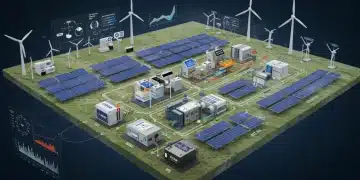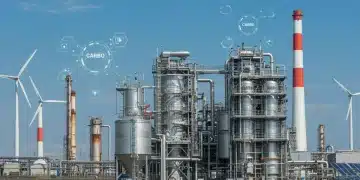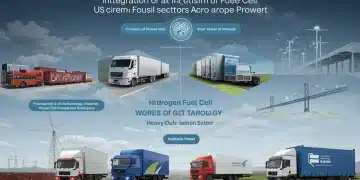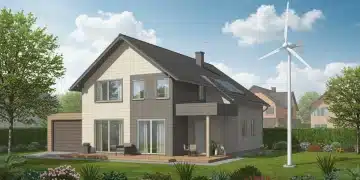Smart Grid Technology: 3 Innovations Reshaping US Energy 2025
Recent advancements in Smart Grid Technology are rapidly transforming the US energy landscape, with three pivotal innovations poised to reshape the sector by 2025, offering practical solutions for enhanced efficiency and resilience.
The US energy sector is currently experiencing a rapid evolution, driven by groundbreaking advancements in Smart Grid Technology Innovations. These developments are not merely incremental; they represent a fundamental shift in how power is generated, distributed, and consumed across the nation, promising a more resilient and efficient energy future by 2025.
Real-Time Grid Optimization with AI and Machine Learning
The integration of Artificial Intelligence (AI) and Machine Learning (ML) into smart grid operations is revolutionizing how utilities manage power flow. These technologies enable real-time analysis of vast data sets, predicting demand fluctuations and optimizing energy distribution with unprecedented accuracy.
As of late 2024, several pilot programs across states like California and Texas are demonstrating significant improvements in grid stability and efficiency. The ability to anticipate and respond to anomalies proactively is a game-changer for preventing outages and integrating intermittent renewable sources more effectively.
Predictive Analytics for Demand Response
AI-powered predictive analytics are crucial for modern demand response programs. These systems learn from historical data and real-time inputs to forecast energy needs, allowing utilities to adjust supply or encourage demand reduction during peak times.
- Enhanced Accuracy: ML algorithms continuously refine demand forecasts, reducing errors by up to 15% in recent trials.
- Automated Adjustments: AI can automatically dispatch distributed energy resources (DERs) or enact load shedding protocols.
- Cost Savings: Optimized energy use translates directly into lower operational costs for utilities and potentially reduced bills for consumers.
Adaptive Grid Control Systems
Adaptive grid control systems, powered by AI, are moving beyond static programming. These dynamic systems can reconfigure grid topology in milliseconds, rerouting power to bypass faults or accommodate sudden changes in generation from renewables.
The immediate practical solution here is a significant reduction in outage duration and frequency. For instance, a recent report from the Department of Energy highlights a 20% decrease in restoration times in areas deploying these advanced control mechanisms.
Advanced Distributed Energy Resource Management Systems (DERMS)
The proliferation of distributed energy resources (DERs) such as rooftop solar, battery storage, and electric vehicles (EVs) has necessitated sophisticated management solutions. Advanced Distributed Energy Resource Management Systems (DERMS) are emerging as critical infrastructure for orchestrating these diverse assets, ensuring grid stability and maximizing their collective benefits.
By 2025, DERMS are expected to become standard in urban and suburban grids, allowing for seamless integration and optimization of localized energy generation and storage. This is a crucial step towards a truly decentralized and resilient energy architecture.
Coordinating Grid-Edge Devices
DERMS platforms provide a centralized control point for thousands of individual DERs, enabling utilities to view, manage, and optimize their operation. This coordination is vital for maintaining voltage stability and frequency regulation, especially as more renewables come online.
- Aggregated Control: DERMS can group numerous small DERs into virtual power plants (VPPs) for grid services.
- Real-time Monitoring: Continuous data streams from DERs allow for immediate detection and response to operational issues.
- Market Integration: Facilitates the participation of DERs in wholesale energy markets, creating new revenue streams for owners.
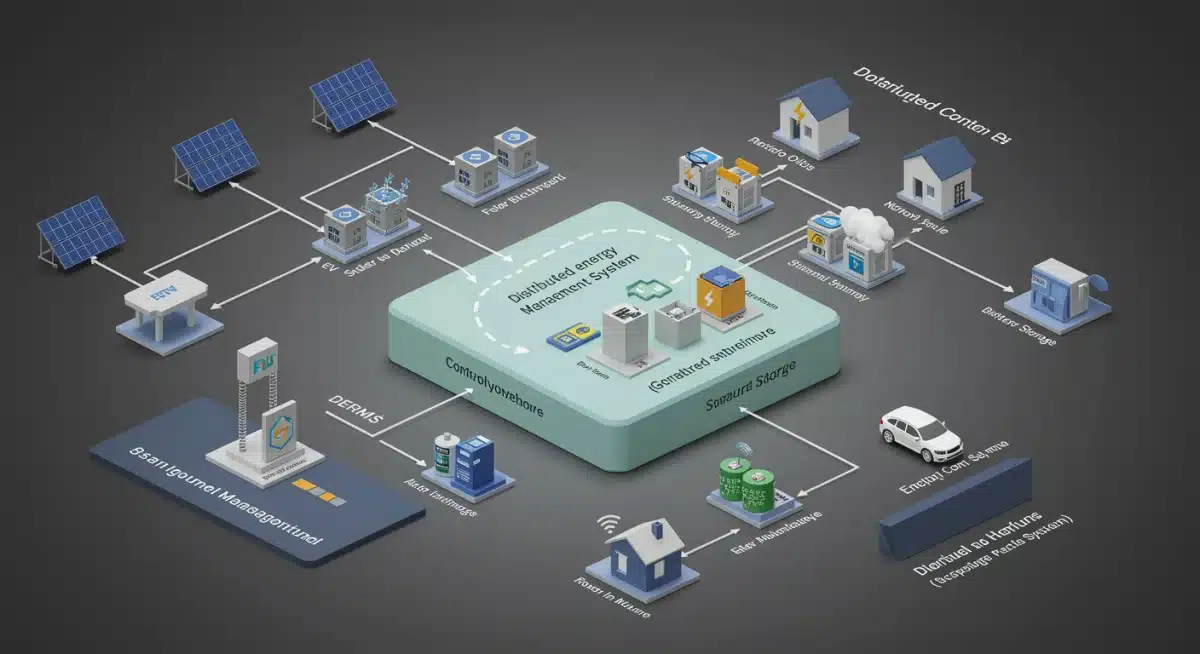
Enhanced Grid Resilience
The ability of DERMS to intelligently manage localized energy resources significantly boosts grid resilience. During a major outage, these systems can isolate affected areas and use local DERs to create microgrids, providing essential power to critical loads.
This capability is particularly important in regions prone to extreme weather events, offering a practical solution for maintaining power during emergencies. Recent deployments in hurricane-prone coastal areas have demonstrated the effectiveness of DERMS in minimizing disruption.
Cybersecurity Innovations for Grid Protection
As smart grids become increasingly interconnected and digitalized, the threat of cyberattacks intensifies. Cybersecurity innovations are paramount to protecting critical energy infrastructure from malicious actors, ensuring the reliability and integrity of the power supply.
New protocols and AI-driven defense mechanisms are being rapidly deployed to safeguard grid operations. The Department of Energy, in collaboration with industry leaders, has recently unveiled initiatives to fortify cyber defenses across the national grid, recognizing the escalating threat landscape.
AI-Powered Threat Detection
Traditional cybersecurity measures are often reactive. AI-powered threat detection systems offer a proactive defense, continuously monitoring network traffic and behavioral patterns to identify and neutralize potential threats before they can inflict damage.
- Anomaly Detection: AI algorithms can spot unusual activities that indicate a cyberattack in progress.
- Automated Response: Some systems can automatically quarantine infected segments or deploy countermeasures.
- Reduced Human Error: Automation minimizes the reliance on human vigilance for initial threat identification.
Blockchain for Secure Data Exchange
Blockchain technology, known for its decentralized and immutable ledger, is being explored for securing data exchange within smart grids. This can enhance the integrity of transaction data, meter readings, and operational commands, making them resistant to tampering.
While still in early stages of implementation, pilot projects are showing promising results in creating a more trustworthy and transparent data environment for energy transactions and grid management. This distributed trust mechanism offers a robust defense against data manipulation.
Grid-Interactive Buildings and Electric Vehicles
The concept of grid-interactive buildings and electric vehicles (EVs) is transitioning from niche applications to mainstream adoption, fundamentally altering demand patterns and offering new avenues for grid support. These innovations are transforming passive consumers into active participants in the energy market.
By 2025, a significant percentage of new commercial and residential constructions are projected to feature grid-interactive capabilities, while vehicle-to-grid (V2G) technology for EVs gains traction, providing mobile energy storage solutions.
Smart Building Energy Management
Grid-interactive buildings utilize advanced energy management systems to optimize their electricity consumption based on grid signals, pricing, and occupant preferences. These buildings can shed non-critical loads or even export power back to the grid during peak demand or high prices.
- Dynamic Load Management: Adjusts HVAC, lighting, and other systems in real-time to balance demand.
- Renewable Integration: Optimizes the use of on-site solar or wind generation, storing excess energy.
- Demand Response Participation: Automatically enrolls in utility demand response programs, earning incentives.
Vehicle-to-Grid (V2G) Technology
V2G technology allows EVs to not only draw power from the grid but also feed electricity back into it. This turns the growing fleet of electric vehicles into a massive distributed battery storage system, offering flexibility and resilience to the grid.
As EV adoption accelerates, V2G has the potential to significantly stabilize the grid by providing ancillary services, such as frequency regulation and peak shaving. Practical solutions are already being piloted with fleet operators and in smart charging hubs.
Enhanced Energy Storage Solutions
Energy storage is a cornerstone of modern smart grids, enabling the effective integration of intermittent renewable energy sources and enhancing grid reliability. Recent advancements in battery technology, including solid-state and flow batteries, are making storage solutions more efficient, cost-effective, and scalable.
These innovations are critical for balancing supply and demand, particularly as the US moves towards higher percentages of solar and wind power. By 2025, utility-scale battery deployments are expected to surge, providing essential grid services.
Next-Generation Battery Technologies
Beyond traditional lithium-ion, new battery chemistries and designs are emerging that promise greater energy density, longer lifespans, and improved safety. These advancements are lowering the cost of storage, making it more accessible for widespread grid application.
- Solid-State Batteries: Offer higher energy density and improved safety characteristics compared to liquid electrolyte batteries.
- Flow Batteries: Provide scalable storage for long-duration applications, decoupling power and energy capacity.
- Hybrid Systems: Combining different storage technologies to optimize performance for various grid needs.
Grid-Scale Storage Deployment
The deployment of large-scale energy storage facilities is rapidly accelerating, driven by policy incentives and declining costs. These facilities can store excess renewable energy during periods of low demand and release it when needed, smoothing out fluctuations and enhancing grid stability.
Recent projects in states like Arizona and California are demonstrating the economic and operational benefits of grid-scale storage, proving its value in providing critical grid services and reducing reliance on fossil fuel peaker plants.
Policy and Regulatory Frameworks Driving Innovation
The rapid pace of smart grid innovation is not solely driven by technological breakthroughs; supportive policy and regulatory frameworks play an equally vital role. Governments and regulatory bodies are actively creating an environment conducive to investment and deployment of these advanced technologies.
Key legislation and initiatives are being enacted at both federal and state levels to accelerate grid modernization, incentivize renewable energy integration, and enhance cybersecurity measures, ensuring that the US energy infrastructure remains competitive and resilient.
Federal Initiatives and Funding
The federal government has earmarked substantial funding for smart grid projects, recognizing their importance for national energy security and climate goals. Programs like the Bipartisan Infrastructure Law are providing grants and loans for grid modernization efforts.
- Grid Modernization Grants: Allocating billions to projects enhancing resilience, reliability, and security.
- Renewable Energy Incentives: Tax credits and other financial mechanisms to encourage clean energy development.
- Cybersecurity Standards: Developing mandatory and voluntary cybersecurity guidelines for critical infrastructure.
State-Level Regulatory Reforms
Many states are implementing progressive regulatory reforms to facilitate smart grid deployment. These include performance-based ratemaking, which rewards utilities for achieving specific grid modernization goals, and streamlined interconnection processes for DERs.
These state-led efforts are crucial for tailoring solutions to local energy needs and accelerating the adoption of new technologies. California’s grid modernization plan, for instance, serves as a blueprint for other states looking to integrate more renewables and enhance grid resilience.
| Key Innovation | Brief Description |
|---|---|
| AI/ML Grid Optimization | Real-time analysis and predictive analytics for enhanced grid stability and efficient energy distribution. |
| Advanced DERMS | Sophisticated systems for managing and orchestrating distributed energy resources for grid resilience. |
| Cybersecurity for Grids | AI-powered threat detection and blockchain for securing critical energy infrastructure. |
| Grid-Interactive Buildings/EVs | Buildings and electric vehicles actively participating in grid management and energy supply. |
Frequently Asked Questions About Smart Grid Innovations
AI and ML enhance smart grids by providing real-time optimization, predictive analytics for demand response, and adaptive control. This leads to increased grid stability, reduced outages, and more efficient integration of renewable energy sources, ultimately lowering operational costs for utilities.
DERMS improve resilience by coordinating various distributed energy resources like solar and battery storage. They can form microgrids during outages, providing localized power and minimizing disruption. This intelligent orchestration ensures stable power supply even when the main grid faces challenges.
Cybersecurity is crucial as smart grids become more digitalized and interconnected, making them vulnerable to sophisticated attacks. Robust cybersecurity measures, including AI-powered threat detection and blockchain, protect critical infrastructure from disruption, ensuring reliable and secure energy delivery.
Grid-interactive buildings and EVs act as active grid participants, optimizing energy consumption based on grid signals and potentially feeding power back. This transforms consumers into prosumers, offering flexible demand management and mobile energy storage that enhances overall grid stability and efficiency.
Latest advancements include next-generation battery technologies like solid-state and flow batteries, offering higher energy density, longer lifespans, and improved safety. These innovations are driving down costs and enabling widespread utility-scale deployments crucial for integrating intermittent renewable energy sources effectively.
Looking Ahead: The Evolving Energy Landscape
The rapid deployment of these smart grid innovations signifies a pivotal moment for the US energy sector. What’s next involves the continued integration of these technologies, making them more interoperable and scalable across diverse regional grids. We can expect to see further policy support and increased private investment driving even faster adoption rates. The focus will remain on enhancing resilience against both cyber and physical threats, while simultaneously accelerating the transition to a cleaner, more efficient energy future. The coming years will define the robustness and sustainability of the nation’s power infrastructure.
